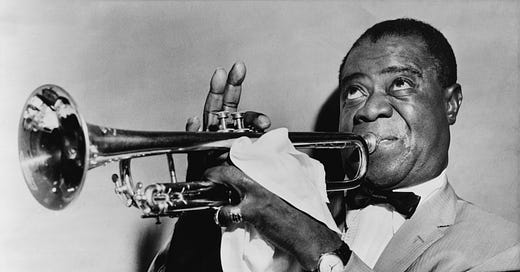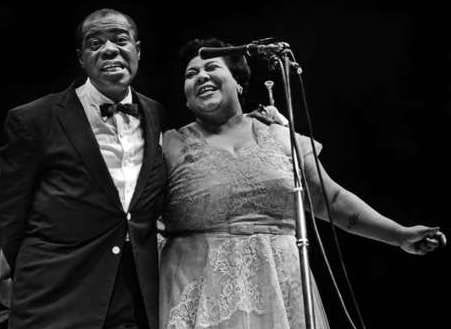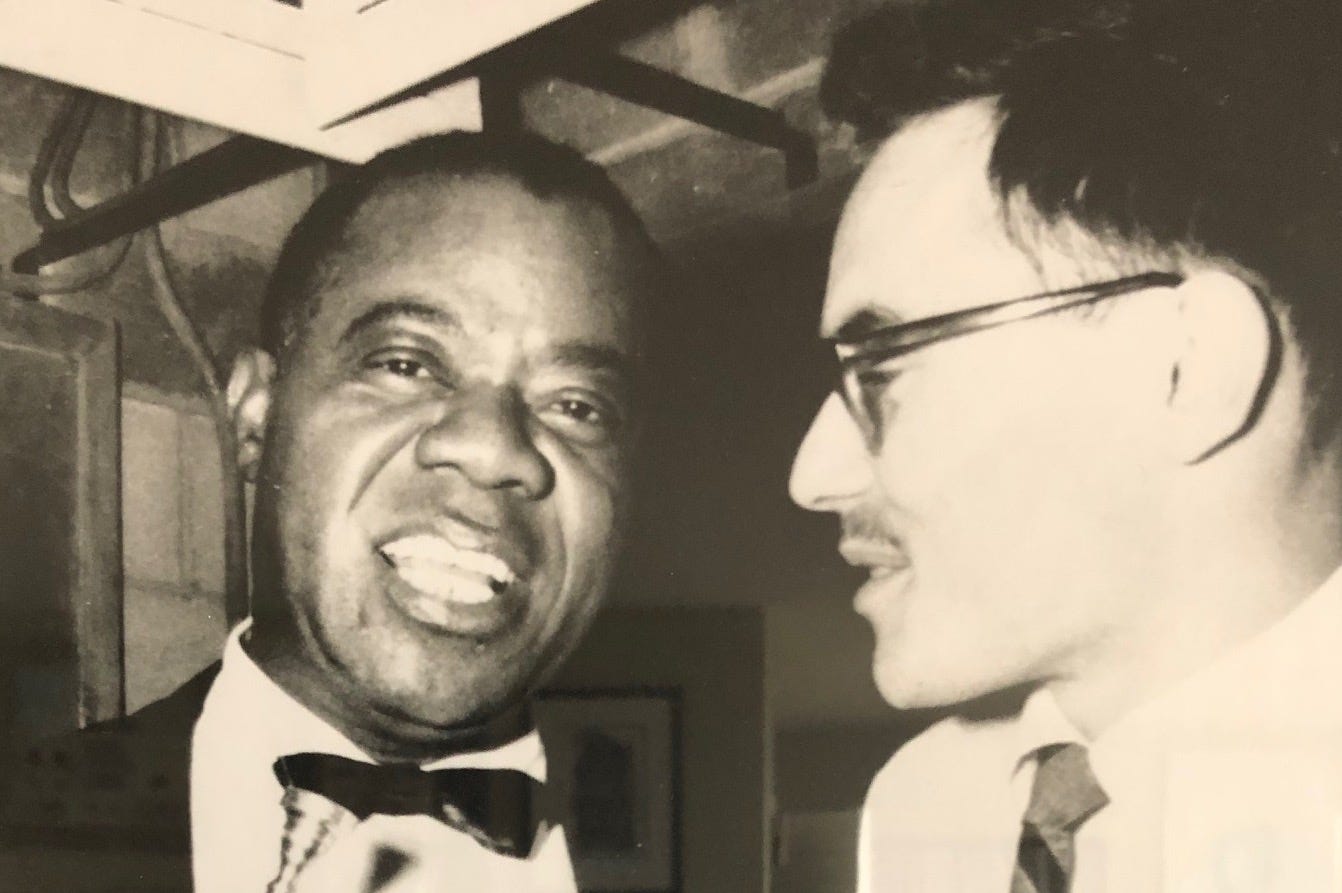Here’s the fourth instalment of a weekly collection of true stories and warm-hearted memories by a publicist and concert promoter who spent more than 50 years in the music business.
Unable to sing, play an instrument or even dance, Richard Flohil is passionate about music.
Based in Toronto, now the fourth largest city in North America, he hopes you’ll find these stories worth your time — and even a $6.00 monthly subscription (or a discounted annual sub). That’ll keep the stories coming and top up his old age pension.
+++++++++++++++++++++++++++++++++++
LOUIS ARMSTRONG: YOU MEET GOD AND HE WANTS TO KNOW ABOUT YOUR BOWEL MOVEMENTS
The sound was unmistakable. From the top corner of the arena, the brilliant, brassy, unique sound of Louis Armstrong’s trumpet cut through the roaring applause. As the spotlight picked him out, he walked down from the upper tiers of the arena, still playing, and finally arriving on the slowly revolving stage, where his musicians, in the dark, had already assembled.
It is May 1956, we are at the Empress Hall, a 10,000-seat hockey arena in Earl’s Court, north London, and Louis Armstrong has returned to Britain for the first time since 1933. The promoters have some idea of the significance of his presence to British jazz fans: the tickets are ruinously expensive. But who cares? The greatest musician of the 20th century is playing in London.
Armstrong has yet to have the major hits that would bring his music to million — “Hello Dolly,” “Mack the Knife,” “What a Wonderful World” — but his history is known to every British jazz fan. Born in New Orleans at the turn of the century, brought north at 22 to play in King Oliver’s band in Chicago, and a New York star career with Fletcher Henderson’s band.
Most important of all is a collection of superb recordings with studio pick-up band in the mid-‘20s, released as Louis Armstrong’s Hot Five or Louis Armstrong’s Hot Seven. There are 55 recordings in all, and they stood then — as they still do today — as the first great masterpieces of jazz history, full of wildly adventurous playing and ground-breaking improvised vocals.
Those recordings, and others by Oliver, Henderson, Jelly Roll Morton and a young Duke Ellington, have been the inspiration for the jazz revival in Britain. And all over the world, thousands of bands — most with more energy than skill — are still playing the tunes Armstrong recorded more than 85 years ago.
British audiences are patient and forgiving. Yet, here at the Empress Hall in Earl’s Court, we are not pleased that we have to sit through a set by Humphrey Lyttelton’s band (who we can hear every week at the 100 Club) and 20 minutes by Vic Lewis with a big band playing Stan Kenton charts.
We want — we need —to hear Louis Armstrong, but here comes Peg Leg Bates, a black vaudeville tap dancer with a wooden leg, followed by singer Ella Logan, and, finally, a comedian called Jack Carter, whose 10-minute routine is obliterated by boos and catcalls.
Looking back 60 years later, it’s hard to remember the show itself, but there are enough recordings from the ‘50s to re-live it. Instrumentally, this is the classic traditional jazz lineup, but it is totally dominated by Armstrong’s trumpet pyrotechnics, his growled vocals, his brow-mopping snow-white handkerchief and his infectious grin.
For every one of the 10,000 people in attendance each night (and he played 10 sold out shows) the performance was less important than the symbolism of his presence. The greatest musician in the history of jazz, the idiom’s first major virtuoso, was here in London, playing live.
Perhaps this wasn’t the greatest band Armstrong had ever fronted, and Billy Kyle wasn’t Earl Hines, the master pianist who had played on those Hot Seven recordings back in the ‘20s. Trummy Young was certainly a more sophisticated player than Kid Ory had been, and Danny Barcelona was a show-off drummer — worse, he was Filipino, and that didn’t sit well with purists expecting “authenticity.” The hugely overweight Velma Middleton was the singer, a perfect foil for Armstrong’s good-natured mugging.
And, yes, Armstrong was a showman — an entertainer — and the grinning and handkerchief waving were certainly not part of those classic records from the ‘20s. No matter. An hour later, as the crowd left, we felt we had, indeed, seen and heard the fountainhead, the genius, the greatest jazz musician of all time. Elated? No, that’s an understatement.
Outside the hall, after the show, I had a brainwave. Hey, I was a reporter; I had my PRESS card. With this, I reasoned, I could return to the hall, find the dressing room, and interview the Great Man. A uniformed commissionaire, af checking my card, re-admitted me to the building and pointed in the direction of the dressing rooms, located in the concrete basement.
The room was crowded with the familiar British jazz players, among them Chris Barber, Kenny Ball, Alex Welsh and more. The room smelled odd; I had no idea that Armstrong was an enthusiastic pot smoker. I thought that the smell, now so familiar, was probably some athletic ointment; we were, after all, in the dressing rooms of what was normally a sports arena.
Stripped to the waist, wearing track pants, black horn-rimmed glasses and a huge white towel on his head, Armstrong sat in his dressing room, in front of a huge mirror rimmed with a dozen light bulbs.
“Mr. Armstrong,” I said earnestly, “thank you SO much for coming to Britain; we are so privileged to have you here. What a wonderful show you gave tonight….” As I burbled on, he interrupted, sounding a little irritated. Some of the surrounding jazz players laughed; perhaps they knew what was going to happen.
“So,” Armstrong growled, looking up at me. “Are ya regular?”
“Regular?”
“Yeah, regular, man. Ya know, regular?”
“Er, I’m not sure…”
“So, do you have gas?”
Impatient with my confusion, he reached over and took a yellow flyer from a pile on the dressing room table. With a flourish of his broad-nibbed fountain pen, he autographed it in bright green ink.
Any idea of an interview now forgotten, I thanked him profusely. Outside, I looked at the flyer. There was a keyhole-shaped photograph of Armstrong, sitting on the toilet, his pants around his knees and a broad grin on his face. The flyer was an advertisement for an herbal laxative called Swiss Kriss. The text read, simply and in bold-face type: "Leave It All Behind Ya."
There’s a post-script to this. More than 60 years later, I visited Louis Armstrong’s house in Corona Heights, a New York City suburb. Now a museum, guides offer a tour around the home Armstrong lived in for more than 40 years. For a mere $10, you get a backward glimpse at the private life of the man whose music, more than 50 years after his death, remains as popular as ever.
And in the gift shop, you can buy a postcard of a slightly different version of the flyer he signed for me so many years before.
And, you’ll be pleased to know, you can also buy packets of Swiss Kriss in health food stores— the laxative is still, apparently, keeping people regular.
++++++++++++++++++++++++++++++++++
THE GREAT MAN’S BEST INTERVIEW
Here’s the very best interview Armstrong ever did — a late-night television chat with Dick Cavett. Make sure you come back to it when you’ve read the rest of this week’s Stories from the Edge of Music.
++++++++++++++++++++++++++++++++++
THE BEST LOUIS ARMSTRONG STORY OF ALL
There are many stories about the man who remains the best-known jazz musician of all time, and some of the best relate to his lifelong consumption of marijuana, which he rightly regarded as a harmless, organic herb. Louis Armstrong went on record in one of his chaotic, funny autobiographies: “It puzzles me to see marijuana connected with narcotics… dope and all that crap. It’s a thousand times better than whiskey. It’s an assistant, it’s my friend.”
In the early ‘50s, Armstrong was returning to the United States after a State Department-sponsored tour of the Far East — this was an era when the U.S. government sent musicians overseas to make friends for America, rather than armies.
Sitting next to him was then-Senator Richard Nixon, strongly tipped to run as Eisenhower’s vice-president. It was a long flight — but in this instance an enjoyable one. Both men were serious sports fans, and conversation about baseball, football and basketball passed the time.
As the passengers left the plane, Armstrong turned to his new companion. “I’m very tired, Senator. Would you carry my horn for me? Of course, Nixon agreed, unwittingly carrying not only Armstrong’s trumpet case through customs, but the goodly stash of excellent weed it contained.
Like many Armstrong legends, that’s a tough one to confirm. A few years ago, meeting the clarinet player in the last version of the Armstrong All Stars, I asked about the story — was it really true?
“I dunno, man,” he replied. “But it could be true, it sounds like it’s true, and so as far as I’m concerned, it IS true.”
+++++++++++++++++++++++++++++++++
FLOHIL’S RULES FOR PERFORMERS #3
Always introduce yourself to your audience, even if someone’s just done it. And when you close your set, remind the audience who you are.
++++++++++++++++++++++++++++++++
THIS WEEK’S STRANGE VIDEO
Here’s Humphrey Lyttelton, the best of the British “trad jazz” players and an early hero. No prizes if you can name the Beatles song inspired by the piano intro…
+++++++++++++++++++++++++++++++
There you have it — Stories from the Edge of Music #4. Next week, stories about k.d. lang that even she doesn’t know. If you’re a free subscriber, please considering taking up a paid sub — at $6.00 a month it’s about what you’d pay for a couple of coffees… and it keeps the writer chained to his keyboard.








Thanks for bringing the rich and nourishing presence of Satchmo back in this tired and needy world of today. Love your eyes and ears.